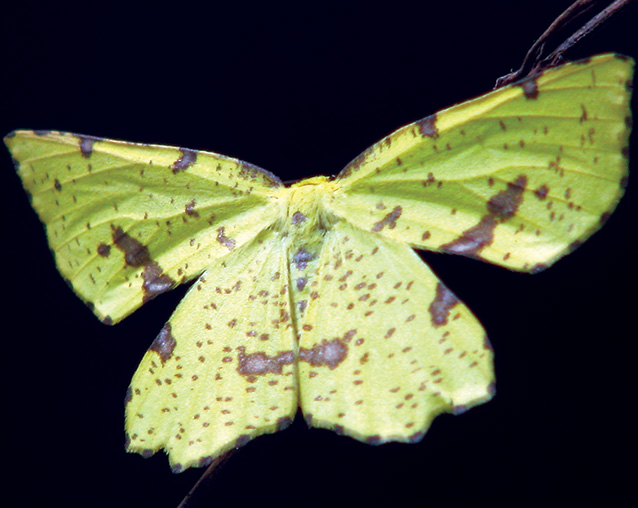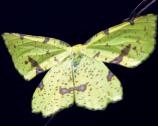
NPS Photo/Theresa A. Thom
RESEARCH PARTNERS with the NPS Old-Growth Bottomland Forest Research and Education Center (the Center) have recently published final studies on Rafinesque’s big-eared bats (Lucas et al. 2015) and moth biodiversity (Culin et al. 2014) at Congaree National Park (South Carolina). These studies each offer their own insights into old-growth floodplain forest ecology, but considered together they reflect something bigger: an evolving, multiyear collaboration between NPS staff and research partners that exemplifies the NPS Research Learning Center (RLC) network mission to “increase the effectiveness and communication of science in national parks” (NPS 2015). Such work provides fundamental value—not just value added—for park management and interpretation efforts as well as a host of NPS strategic initiatives that include (among many) Call to Action item 20 (Scholarly Pursuits) and all items under the “Preserving America’s Special Places” theme (NPS 2014), the Revisiting Leopold Report (National Park System Advisory Board 2012), and the original 1999 Natural Resource Challenge program that created the RLCs (NPS 2012).
These studies built on the work of the Southeast Coast Inventory and Monitoring Network to inventory bats and other mammals, which are vital sign indicators of a park’s health. The bat portion of the mammal inventory, conducted by a research scientist from the USDA Forest Service, documented six bat species at Congaree (Loeb 2006). These included Rafinesque’s big-eared bat (Corynorhinus rafinesquii) and the southeastern myotis (Myotis austroriparius), which are species of conservation concern. Scientists and managers know relatively little about the ecology of these species. While the Southeast Coast Network moved on to other inventory and monitoring surveys in accordance with their mission, staff of the Center partnered with the USDA researcher and secured a grant to follow up with a conservation biology study of Rafinesque’s big-eared bat.
The study, which resulted in one master’s thesis (Lucas 2009) and culminated in the publication of Lucas et al. (2015), focused on tree roost use and selection by Rafinesque’s big-eared bats in Congaree’s old-growth floodplain forest. Rafinesque’s big-eared bats were netted and tagged with radio transmitters. Bats were re-located and their roost trees were described in relation to forest characteristics in the surrounding area. Research showed that the ideal bat roosts were very large, hollow, live-but-damaged water tupelo (Nyssa aquatica) trees in areas with abundant old-growth trees and relatively high (seasonally to semipermanently flooded) water levels. Maternity colonies moved around more frequently and preferred trees with upper cavities relative to solitary males, who were more likely to reoccupy trees with only basal cavities. Researchers suggested the maternity colony roost switching helped to minimize threats to young from predation, rising water levels, and parasites.
At a local level, these results can help park staff identify and manage prime roost habitat while informing interpretation of bats, champion trees, and popular night programs. By documenting bat roost preferences in one of the largest and best-preserved tracts of old-growth bottomland forest remaining on the continent, these results also represent novel, baseline information for both scientists and resource managers working across the larger southeastern and Gulf coastal plains. At a continental scale, scientists are interested in forested bat habitats of the Southeast because white-nose syndrome, a fungal disease, has devastated bat populations in many of the cooler cave systems across North America; populations in forested habitats may be more resilient to the spread of white-nose syndrome, but more work is needed to understand population dynamics, distribution, and ecology.
From bats to moths
During the bat research, partners and NPS staff identified an additional research question: What were the bats eating? Moths were presumably a major food source, but they were not an I&M vital sign and had not been well studied locally or regionally. Staff at the Center collaborated with new academic partners and secured another grant to research the park’s moth communities. New research partners included entomology faculty from three universities, one of which is a specialist in micro-lepidoptera who had partnered with other RLCs on moth inventories for Acadia (Maine) and Great Smoky Mountains (Tennessee and North Carolina) National Parks.
Researchers worked with park staff and youth interns to systematically sample moths at several sites monthly for a year. Sampling used a combination of blacklight traps and trees baited with a mixture of molasses and beer. Researchers also helped to lead several “moth-blitz” programs that engaged the public in moth collection and identification from backlit bedsheets. The results of the study increased Congaree’s known moth list from 40 species, 40 genera, and 10 families to 1,014 species, 546 genera, and 48 families (fig. 1) (Culin et al. 2014; also see Snyder 2015)! These results are estimated to reflect 90% of the park’s total moth biodiversity. Overall moth abundance peaked from April to September but dropped from November to February. Nonnative species were detected in very low numbers, and there were several species unique to bald cypress and floodplain habitats. A total of 173 species were previously unreported from South Carolina, and for some species the closest known occurrence was as far away as New Jersey or Arizona.
At a local level, these results of this study provide a baseline for moth diversity, abundance, and phenology at Congaree. Results confirm that the park provides high-quality habitat for a large population that includes specialized endemic species. Interpretively speaking, moths are ubiquitous and charismatic micro-fauna that are good indicators of ecosystem condition. This makes them very relevant “tangible” resources for interpreting floodplain forest ecology and stewardship. An official species count of over 1,000 represents a positive psychological threshold when interpreting the meaning of biodiversity at Congaree, an international biosphere reserve. At a regional scale, these results compare well to other longer-term moth-sampling efforts and help document moth distribution across North America.
The intertwined story of these two publications points to enduring support of three strategic goals outlined in the recent RLC strategic framework: (1) to “promote national parks as premier places for scientific inquiry,” (2) to “facilitate and promote the use of science to make resource management decisions,” and (3) to “improve science literacy by incorporating science into park visitor and staff experiences” (NPS 2015). This is not, however, the end of the story. Staff and partners at the Old Growth Bottomland Forest Research and Education Center have begun a parallel bat ecology study focused on the southeastern myotis. Fieldwork is under way, and research partners are also pursuing additional work to monitor for white-nose syndrome at Congaree. Furthermore, this work is but one example of similar efforts through the Center and other RLCs across the country. These research collaborations do not happen quickly, easily, or randomly, but take long-term vision, support, and dedication to bring to fruition. The fundamental value to the National Park Service, however, is very real as we increasingly leverage science to inform and inspire both appreciation and stewardship of our parks as we head into our second century.
References
Culin, J. D., B. Scholtens, and J. Snyder. 2014. Characterization of the moth (Lepidoptera) diversity of Congaree National Park. Final Report for National Park Service. Contract H5000085050/J5430090058. On file at Congaree National Park, Hopkins, South Carolina, USA.
Loeb S. 2006. Bat inventories of Chattahoochee River National Recreation Area, Congaree National Park, Fort Pulaski National Monument, Fort Sumter National Monument, and Ocmulgee National Monument. Clemson, South Carolina. Unpublished Report 630183. Accessed 11 January 2016 from https://irma.nps.gov/App/Reference/DownloadDigitalFile?code=434513&file=Loeb_2006_SECNBatInventories.pdf.
Lucas, J. S. 2009. Roost selection by Rafinesque’s big-eared bats (Corynorhinus rafinesquii) in Congaree National Park: A multiscale approach. Thesis. Department of Wildlife and Fisheries Biology, Clemson University, Clemson, South Carolina, USA.
Lucas, J. S., S. C. Loeb, and P. G. R. Jodice. 2015. Roost selection by Rafinesque’s big-eared bats (Corynorhinus rafinesquii) in a pristine habitat at three spatial scales. Acta Chiropterologica 17(1):131–141. doi:10.3161/15081109ACC2015.17.1.011.
National Park Service. 2012. Natural Resource Challenge: The National Park Service’s Action Plan for Preserving Natural Resources. Accessed 12 January 2016 from https://www.nature.nps.gov/challenge.
———. 2014. A Call to Action: Preparing for a Second Century of Stewardship and Engagement. Washington, D.C., National Park Service, 28 pp. Accessed 11 January 2016 from https://www.nps.gov/calltoaction.
———. 2015. Strategic framework for National Park Service Research Learning Centers. National Park Service Division of Natural Resource Stewardship and Science, Washington, D.C. 3 pp. Accessed 11 January 2016 from https://www.nature.nps.gov/rlc/framework.pdf.
National Park System Advisory Board. 2012. Revisiting Leopold: Resource stewardship in the national parks. National Park System Advisory Board, Science Committee, Washington, D.C. 16 pp. Accessed 11 January 2016 from https://www.nps.gov/calltoaction/PDF/LeopoldReport_2012.pdf.
Snyder, J. 2015. South Carolina moths searchable checklist. Department of Biology, Furman University, Greenville, SC. Last accessed 11 December 2015 from http://insect.furman.edu/sc-moths.
—David C. Shelley and Theresa A. Thom
Download: PDF of this article
This article published
Online: 6 May 2016; In print: 25 March 2016
URL
https://www.nps.gov/ParkScience/articles/parkscience32_2_7-8_3830.htm
Suggested citation
Shelley, D. C., and T. A. Thom 2016. Bats, moths, and Research Learning Centers: A story of collaborative research. Park Science 32(2):7–8.
This page updated
5 May 2016
Site navigation
• Back to Volume 32, Number 2
• Back to Park Science home page
Last updated: March 21, 2021

